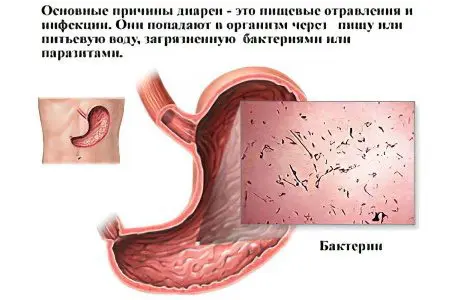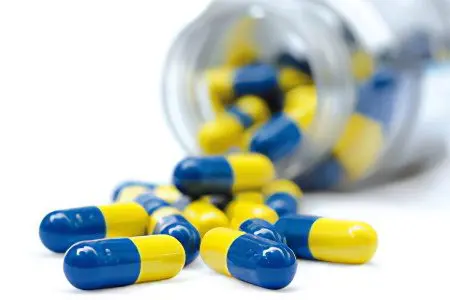Contents
- Differences between normal stool and diarrhea
- Causes of diarrhea in adults
- Types of diarrhea
- Symptoms of diarrhea
- What does the color of bowel movements indicate in diarrhea?
- Diagnosing diarrhea
- Diarrhea treatment
- When does the treatment of diarrhea require medical attention?
- Diarrhea with and without fever
- Treatment of diarrhea accompanied by high body temperature
- What diseases are accompanied by diarrhea with blood?
- Can diarrhea be a sign of pregnancy?
Diarrhea is a bowel disorder characterized by frequent bowel movements and watery stools. The main danger of diarrhea is that it can lead to dehydration. There can be several reasons for diarrhea – for example, infection entering the body, nutritional errors, stress, poisoning.
It is not necessary to exclude such possible causes of diarrhea as intestinal dysbacteriosis or parasitic invasion (pinworm infection). To make a correct diagnosis, it is important to take into account all the criteria: the frequency of the stool, the nature of the smell emanating from it, the color of the stool, the presence of pathological impurities.

Before rushing to make a self-diagnosis, it is necessary to take into account that the frequency of stool varies from person to person. The act of defecation in one person can happen 2 times a day, and in another – 1 time in 4 days. The same applies to the consistency of feces. So, in some people they are constantly mushy, while in others they are decorated. If a person for many years has a stool several times a day and has a mushy consistency, and his well-being is not disturbed, then this will be considered the norm, and not diarrhea.
When impurities are present in the stools and an uncharacteristic odor emanates from them, this indicates diarrhea. Sometimes even a change in the type of feces allows you to identify diarrhea. Be sure to pay attention to your own bowel movements, as they are a criterion for assessing the functioning of the digestive system, and hence the state of health in general.
Diarrhea is a pathological condition of the body, in which there is an increase in the volume of feces and their liquefaction. With diarrhea, foreign impurities are almost always present in the stool.
Differences between normal stool and diarrhea
Criteria for evaluation | normal stool | Diarrhea |
How often does stool happen | 1-2 times per day | 3-4 times a day or more |
stool consistency | Porridge | Liquid consistency or liquid slurry |
Color of bowel movements | Dark yellow to dark brown | Green, yellow, white, blood-pink, black, cherry, brown |
The nature of the bowel movements | Formed feces with a uniform consistency | Unformed, with foam, liquid |
Smell | Characteristic odor of feces, without stench | Odorless, either offensive or sour |
Impurities | May have a small amount of mucus | Large amounts of mucus, undigested food |
Causes of diarrhea in adults

Disturbances in the work of the digestive system lead to liquefaction of the stool and an increase in the urge to defecate.
The most common causes of diarrhea are viral and bacterial infections and food poisoning. Salmonella and Escherichia coli bacteria are the most common causative agents of intestinal diseases. They are able to enter the human body with food or water. Tourists who travel to exotic countries are at an increased risk of intestinal infection.
Diarrhea can also be provoked by herpes simplex and hepatitis viruses. It is possible to increase the frequency of stool against the background of taking antibacterial drugs.
Ulcerative colitis is a disease that always provokes severe diarrhea. You can detect the disease during a colonoscopy.
The functioning of the digestive organs directly depends on the state of health in general. Therefore, almost any failure in the coordinated work of a single body system can provoke the development of diarrhea.
Causes that lead to diarrhea:
Viruses:
Enteroviruses.
Rotaviruses.
Adenoviruses.
Bacteria:
Salmonella.
Shigella causing dysentery.
Vibrio cholerae.
Food bacteriotoxicosis.
Escherichia coli.
Low activity of pancreatic enzymes:
Inflammation of the pancreas.
The presence of stones in the gallbladder and its ducts, which provokes a violation of the normal outflow of bile.
Hereditary and acquired fermentopathy.
Congenital food intolerance.
Bowel disease:
Enterocolitis and enteritis.
Ulcerative colitis.
Crohn’s disease.
Whipple’s disease.
The presence of a tumor in the body:
Polyp formed in the intestine.
Adenocarcinoma.
Diverticulosis in the inflammatory phase.
Diseases of an autoimmune nature:
Systemic lupus erythematosus with involvement in the process of intestinal inflammation.
Rheumatoid arthritis.
Allergies, including atopic dermatitis.
Poisoning:
Lots of nitrates.
Poisons and heavy metals.
Household chemicals.
Taking certain medications:
Antibacterial agents.
Cytostatics.
Laxatives in large quantities.
Prokinetics, anticholinesterase drugs.
Internal bleeding:
With gastric and duodenal ulcers.
With ulcers in the small and large intestines.
Antibiotics and diarrhea
Diarrhea often occurs while taking antibacterial drugs or after the completion of a therapeutic course. Antibiotics provoke the death of not only pathogenic, but also “good” bacteria that live in the intestine. As a result, a person develops dysbacteriosis, which is expressed by liquefaction and increased stool. Also, taking antibiotics can provoke pseudomembranous colitis. This disease is difficult to treat and is characterized by debilitating diarrhea.
Although viral and bacterial intestinal infections are more likely than others to provoke a violation of the stool, most of these diseases pass safely. And the body copes with them on its own.
It is much more difficult for the immune system to cope with diarrhea of toxic origin on its own.
Depending on what exactly caused diarrhea, the mechanism of its development will differ.
Type of diarrhea | Cause of diarrhea |
Secretory diarrhea, in which there is an active secretion of mucus by intestinal cells | Tumor, inflammation of the intestine |
Motor diarrhea, which is characterized by frequent contractions of the intestinal wall | Any cause other than severe poisoning |
Osmotic diarrhea, when fluid accumulates in the intestines because it is unable to absorb it | Deficiency of pancreatic enzymes |
Invasive diarrhea, when the intestinal wall is affected by representatives of the pathogenic flora | Viruses, bacteria, dysbacteriosis due to antibiotics |
Most often, during diarrhea, several mechanisms of its development are involved at once, but one of them will prevail.
Types of diarrhea

There are the following types of diarrhea:
Dyspeptic. It is provoked by pathologies of the digestive tract: secretory insufficiency of the liver, stomach, pancreas. Food is not able to be digested normally, as there are not enough enzymes for this, which leads to the development of diarrhea.
Infectious. It is caused by various viruses and bacteria.
Alimentary. This diarrhea is provoked by errors in the diet, as well as allergic reactions of the body.
Toxic. It is caused by various poisons, heavy metals that have entered the body. Also, toxic diarrhea can develop in case of poisoning with protein compounds against the background of uremia.
drug-induced diarrhea, which occurs against the background of taking certain medications.
neurogenicwhen loose stools are the result of psycho-emotional arousal.
If diarrhea has an uncomplicated course, then this practically does not affect the well-being of a person. In severe diarrhea, there is depletion of the body, which is accompanied by leaching of vitamins and minerals from it.
Symptoms of diarrhea

Diarrhea is characterized by a certain set of symptoms, which does not complicate its diagnosis. There are also a number of signs that allow you to clarify the cause of the disease. If necessary, the doctor prescribes additional examinations to the patient to make a diagnosis.
Diarrhea and high body temperature. An increase in body temperature is observed during diarrhea quite often. In most cases, fever indicates a bacterial or viral nature of the diarrhea.
When pathogens enter the intestines, the immune system begins to produce antibodies that are designed to fight them. This process is accompanied by an increase in body temperature.
The intestine is one of the organs with a high immune potential, so hyperthermia when it is damaged is a normal reaction of the body. It indicates that the person is actively resisting the infection. Particular caution should be exercised when, with a bacterial or viral intestinal infection, the temperature remains within the normal range.
Depending on how pathogenic viruses or bacteria are, body temperature can be either subfebrile or reach feverish levels of 39 ° C.
Diarrhea with nausea and vomiting. Vomiting and nausea are frequent companions of diarrhea, since when the intestines are damaged, the work of all organs of the gastrointestinal tract is disrupted. The normal movement of food and feces becomes impossible, which causes characteristic disorders.
A malfunction in the intestines provokes poisoning of the body, since harmful substances are absorbed into the blood and carried with its current, penetrating into all tissues and organs. The vomiting center, which is located in the brain, reacts to such disorders, which explains the appearance of a feeling of nausea, and then vomiting develops – the body’s natural defense mechanism, with which it tries to get rid of the maximum amount of toxins.
Abdominal pain and diarrhea. The intestines with diarrhea work in an enhanced mode, which causes severe cramping abdominal pain that occurs in the form of seizures. The pain appears sharply, intensifies and gradually fades away. Most often, after such an attack of pain, a person has an urge to empty the intestines.
The most intense pain in the abdomen is observed with food poisoning or with microbial damage to the intestine. In other cases, diarrhea is less painful for a person.
Belching and diarrhea. Belching, which is accompanied by the appearance of an unpleasant rotten smell, most often indicates that the pancreas, stomach or gallbladder cannot cope with their functions. This belching most often precedes diarrhea.
Food stagnates in the gastrointestinal tract, is not completely digested, and begins to rot. This leads to the fact that an excess of gases is formed in the body, which exit through the stomach, esophagus and mouth. This is exactly the mechanism for the occurrence of rotten belching with diarrhea. Moreover, the liquefaction of the stool indicates that the underlying disease continues to progress.
What does the color of bowel movements indicate in diarrhea?

The doctor-diagnostician, by the color of the feces alone, can suggest what the cause of diarrhea is. Of course, to clarify the diagnosis, it will be necessary to collect a complete history of the patient, listen to all his complaints, and conduct a high-quality medical examination.
If the stools are green. Viral and bacterial diarrhea most often leads to the fact that stools become green in color. This is due to the fact that leukocytes are present in large quantities in feces, as well as pyogenic bacteria, which actively multiply against the background of a decrease in the body’s natural defenses.
The feces are liquid, its composition is heterogeneous, it contains green streaks and inclusions, there is a viscous greenish mucus. In this case, the patient most often has a high body temperature, he is disturbed by abdominal pain, vomiting and nausea are possible. The body suffers from general intoxication. Blood tests indicate an acute inflammatory process (more on green stool ➤).
If the stools with diarrhea are yellow. When the feces have a yellowish tint, most often this is due to too intense contractions of the intestine. At the same time, the feces do not have time to take on their characteristic shape and color, since the intestines move it too quickly to the anus. There are no other pathological symptoms, there may be complaints of mild pain in the abdomen, a feeling of heaviness in the epigastric region (more about the yellow color of feces ➤).
If the stools with diarrhea are black. When the stool is black in color, which resembles tar, it indicates internal bleeding. Under the action of hydrochloric acid, erythrocyte hemoglobin is destroyed and replaced by hematin hydrochloride, which leads to such a color of feces. Stomach bleeding is a dangerous condition that requires immediate medical attention.
However, sometimes stools turn black when eating coloring foods, such as beets or blueberries. Certain medicines give it a darker color: activated charcoal, bismuth preparations.
Additional symptoms, such as a sharp deterioration in well-being, tachycardia, and a drop in blood pressure, will indicate the pathological cause of black stool staining (more on black stool ➤).
If the stools with diarrhea are white. White stool indicates that it has not been fully processed by bile. The reason for such a failure in the digestive system may be that the bile ducts are blocked by a tumor or stone.
In addition to diarrhea with white stools, the patient complains of high body temperature. The skin at the same time acquire a yellow tint, urine, on the contrary, becomes very dark. Diarrhea is not characterized by high intensity, it happens several times a day (more on white stool ➤).
If there is blood in the stool. Diarrhea with blood requires immediate medical attention. It may indicate a severe intestinal infection, or a tumor in the intestine that has begun to decompose. Perhaps the intestinal wall was damaged by chemical compounds or poisons. Stools with bloody diarrhea may be thin and dark cherry in color. This indicates that the source of bleeding is in the right side of the large intestine (What to do if you find a stool with blood? ➤).
If there is mucus in the stool. Mucus may be present in stools in diarrhea caused by any cause. If the mucus is transparent, then most likely we are talking about mild food poisoning. When the mucus becomes green or blood appears in it, the disease has a severe course, or the effect of the treatment is absent.
If the stools are watery. Watery stool indicates cholera. At the same time, diarrhea is strong, stools are plentiful, which threatens to dehydrate the body. A person with cholera needs medical attention with intensive fluid therapy.
Diagnosing diarrhea

If it is not difficult to establish the very fact of the presence of diarrhea, then it is often quite difficult to determine the reasons that caused it. To establish the etiological factor that led to the violation of the chair, doctors use various laboratory, clinical and instrumental techniques. A set of clinical methods: examination, questioning, palpation.
During the patient’s appointment, the doctor asks him a number of clarifying questions:
How long ago did the diarrhea start?
Does anyone in the family suffer from diarrhea?
What did the person eat before he had diarrhea?
Has anyone else eaten a similar food and does he have a gastrointestinal upset?
Does your stomach hurt? How can the patient describe the pain?
During palpation of the abdomen, the doctor will determine areas that are hypersensitive. Percussion of the intestine will reveal the sections of the intestine in which the most gases accumulate.
Laboratory diagnostics:
Delivery of feces for analysis with a coprogram. This study allows you to identify abnormalities in the liver or enzymatic insufficiency of the pancreas.
Conducting a bacterial study of feces. This diagnostic method will provide information about the infectious nature of diarrhea, or will reveal dysbacteriosis.
Biochemistry of blood. Certain changes in the composition of the blood make it possible to determine hepatitis, pancreatitis or cholecystitis.
UAC. The blood picture allows you to suspect inflammation of any organ: the gallbladder, pancreas, appendix, intestines. An allergy may also be suspected.
Diarrhea treatment
Before proceeding with the treatment of diarrhea, it is necessary to determine the cause that caused it.
Cause | Treatment |
bacteria or viruses |
|
Insufficient production of enzymes in the body | Enzyme intake |
Diseases of the intestine |
|
Internal bleeding |
|
Poisoning |
|
Diarrhea due to antibiotic therapy |
|
Medicines for the treatment of diarrhea

The choice of one or another drug for the treatment of diarrhea should be justified by the reasons that provoked disturbances in the work of the digestive organs.
You can use the following medicines:
To eliminate diarrhea – Stopdiar, Loperamide.
For intestinal disinfection – Enterofuril.
To reduce the activity of the intestinal walls – Atropine.
As a sorbent – activated carbon.
As an astringent – preparations of bismuth.
To normalize the intestinal flora – Enterol.
Bacterial diarrhea requires intestinal antibiotics and antiseptics. If the patient has irritable bowel syndrome, then he is shown taking drugs aimed at reducing the activity of the organ. Sometimes the patient is prescribed a complex treatment with the intake of sorbents, bismuth preparations and probiotics.
Cause of diarrhea | How to treat | How to treat |
Bacterial nature of diarrhea | Complex treatment with the use of sorbents and antiseptic preparations is required. Sorbents are necessary for the speedy removal of pathogenic flora from the body and preventing its absorption into the blood. Intestinal antiseptics are detrimental to bacteria, but do not affect the intestinal microflora. To prevent dysbacteriosis, probiotics are prescribed. To prevent dehydration of the body, it is necessary to conduct rehydration therapy. |
|
Viral and parasitic diarrhea | It is necessary to take sorbents, drugs aimed at restoring the disturbed intestinal microflora. With severe diarrhea, drugs are prescribed to inhibit intestinal secretion. In order to prevent dehydration, rehydration therapy is carried out. |
|
Diarrhea associated with bowel disease, such as colitis | To compact the intestinal wall and reduce its permeability, the patient is prescribed drugs that have enveloping and astringent properties. As a result, the volume of water in the intestinal lumen decreases. | Astringents: Tannacomp, Almagel, Neointestopan. |
Diarrhea due to irritable bowel syndrome | Drugs to stop diarrhea are prescribed for severe illness. They should not be taken for more than 2-3 days. It is possible to undergo a course of treatment with tricyclic antidepressants, as well as drugs that belong to the group of antidiarrheal drugs that have a plant base. |
|
Diarrhea due to antibiotic therapy | Probiotics, which allow you to normalize the natural microflora of the intestine. They are taken in parallel with antibacterial drugs for the treatment of the underlying disease. This measure is the prevention of dysbacteriosis. When taking probiotics is late, they are prescribed after antibiotic therapy and in large doses. Preparations for the normalization of the intestinal microflora, taken during diarrhea, can make it less intense, and also produce an antimicrobial effect. Such drugs are prescribed for frequent exacerbations of colitis, as well as in the case when the patient is forced to eat through a tube. | The following medicines allow the normalization of the intestinal microflora: Linex, Enterol, Bifidumbacterin, Lactulose, Goodluck, Acylact, Colibacterin, Bifiform. |
It is possible that diarrhea develops against the background of other diseases, for example, with a deficiency of the lactase enzyme or in the presence of a hormonally active tumor in the body. It is possible that it will be possible to get rid of diarrhea simply by eliminating any particular product from your diet. So, lactase deficiency requires the rejection of milk, celiac disease – from foods with gluten, phenylketonuria – from foods with phenylalanine.
Do I need to take antibiotics for diarrhea? Intestinal antibiotics are used to eliminate pathogenic flora. Their reception is indicated in the case when the bacterial nature of diarrhea is confirmed, or provided that the diarrhea was provoked by severe dysbacteriosis. You cannot prescribe antibiotics on your own.
In addition to antibiotics, it is possible to use drugs that slow down intestinal motility. One of the representatives of this group is Loperamide. Its reception allows you to make the movement of feces through the intestines slower.
Another group of drugs that are used to treat diarrhea are enterosorbents. Their reception allows to reduce the intoxication of the body, as they absorb harmful substances from the intestinal lumen. Effective intake of enterosorbents for diarrhea of an allergic and toxic-infectious nature.
Products containing beneficial bacteria are called probiotics. These are drugs such as Bifidumbacterin, Linex and Hilak forte. They are prescribed in the case when diarrhea is provoked by taking antibiotics, or with diarrhea against the background of dysbacteriosis.
About home treatment for diarrhea

In some cases, it is possible to treat diarrhea at home. At the same time, a person must competently organize his day, eat right, drink enough water and take medications.
To avoid dehydration, you should promptly replenish the supply of salts and minerals that were lost during diarrhea. To do this, you need to use the drugs Ringer Locke, Regidron, Hydrovit, etc. Drinking water with gas will be under the strictest ban. Do not drink juices and sweet water.
The field of the next visit to the toilet must drink at least 300 ml of water. If a person vomits after drinking a saline solution, then you should consult a doctor. In a medical institution, the patient will be put on a drip, otherwise it will not be possible to avoid dehydration.
To reduce the intensity of diarrhea, you can eat foods that have astringent properties. It can be boiled rice, bananas, crackers.
You can not eat fried foods that contain a lot of spices or seasonings, you must give up dairy products, sweets and starchy foods.
When does the treatment of diarrhea require medical attention?

Often diarrhea is caused by indigestion, and you can deal with it on your own. However, there are situations in which medical assistance is indispensable.
It is necessary to contact a medical institution in the following cases:
The presence of blood impurities in the stool. Blood can indicate serious pathologies, for example, ulcerative colitis, intestinal cancer, exacerbation of hemorrhoids, anal fissure.
If diarrhea is accompanied by the release of black feces, then this may be a symptom of internal bleeding, which is possible against the background of peptic ulcer of the stomach and duodenum, or with Crohn’s disease.
If, in addition to diarrhea, a person experiences severe pain in the upper abdomen, and he is also worried about increased gas formation, then this may be a sign of pancreatic enzymatic insufficiency. A similar phenomenon often develops against the background of exacerbation of chronic pancreatitis.
If the stools against the background of diarrhea have a light color and an oily consistency, then this indicates insufficient processing of food masses with bile. It is allocated in insufficient quantities in liver diseases (cirrhosis and hepatitis), or in cholecystitis. Blockage of the bile ducts by stones can also be manifested by diarrhea with white stools.
If a person observes diarrhea, accompanied by increased gas formation while eating certain foods, then it may be of an allergic nature. Although it is also impossible to exclude enzymatic deficiency.
If liquefaction and frequent stools occur regardless of food intake, then irritable bowel syndrome can be suspected. In this case, frequent neuroses, depressions and other disturbances in the work of the nervous system will be observed.
If diarrhea is accompanied by vomiting and severe abdominal pain, then the person may have had food poisoning. Also, these symptoms may indicate an enterovirus infection or salmonellosis.
Diarrhea that causes severe dehydration may be a sign of a severe infection. Patients with dehydration must receive treatment in a hospital setting.
Diarrhea with and without fever
An increase in body temperature against the background of diarrhea does not always occur. More often, hyperthermia is observed in children than in adults, even if the stool disorders were caused by the same reasons. Depending on what exactly served as the trigger for the development of diarrhea, body temperature will fluctuate in a different range.
What is the cause of diarrhea | Range of fluctuations in body temperature | Feature of the hyperthermic reaction |
Neurogenic cause:
| Normal or subfebrile body temperature is not higher than 37 °C. | Body temperature remains within the normal range, its short-term increase to 37,5 ° C is possible. |
Food poisoning in the acute phase. | 37-38,5 ° C. | Body temperature rises 6-12 hours after a person has eaten the food that triggered the diarrhea. The more severe the poisoning, the brighter the hyperthermic reaction of the body. With food poisoning, the mark on the thermometer rarely exceeds 38,5. |
Virus infection:
| 37-38 ° C | Viral infections most often do not cause body temperature to rise above 38 °C. In this case, a person suffers from general intoxication of the body. He develops muscle pains, sweating increases, hot flashes and cold flashes occur. Diarrhea with elevated body temperature persists for 3 days, but no more. The body then fights off the infection. |
Inflammation of the digestive system:
| 37,1-38,5 |
|
Parasitic infestations:
| 38-38,5 | The defeat of the body by parasites is accompanied by diarrhea and an increase in body temperature to medium values. It is extremely rare that the readings on the thermometer exceed the mark of 38 degrees. |
Diarrhea of a bacterial nature:
| 38,5-39 | If the digestive organs are affected by a bacterial infection, then the body temperature rises to high levels. When the disease is severe, the mark on the thermometer can reach 40 ° C. |
Treatment of diarrhea accompanied by high body temperature

When a person develops diarrhea, drugs should not be taken to stop it. Therapy directly depends on what exactly caused the diarrhea. The fact is that liquefaction and increased stool against the background of high body temperature are not independent diseases, but only symptoms of any disorders in the body.
High body temperature with diarrhea may indicate the following pathologies:
Food poisoning.
Inflammation of the pancreas.
Inflammation of the intestines.
Virus infection.
Infection with bacteria.
Steps can be taken to reduce the severity of symptoms and improve well-being, but a person’s main effort should be directed towards controlling their condition. In some cases, it is necessary to urgently seek medical help.
Food poisoning. After a person has eaten an expired or poor-quality product, he will begin to show symptoms of poisoning. They can manifest after 1-12 hours. First, diarrhea develops, the stools will be watery, copious and fetid. Pieces of undigested food are found in the feces. In addition to diarrhea, the victim’s body temperature rises, nausea worries, which often ends in vomiting.
To help the patient, it is necessary to perform gastric lavage. In ordinary water, one of the following compositions must be dissolved: potassium permanganate (until a pale pink solution is obtained), 2 tablespoons of baking soda (per 2 liters of water) or 2 tablespoons of salt (per 4 liters of water).
To rinse the stomach well, it will take from 8 to 10 liters of solution. It shouldn’t be too hot or cold. The optimum liquid temperature is 36 °C. The patient drinks 3-6 glasses of the prepared solution, and then provokes vomiting by pressing his fingers on the root of the tongue. Rinse the stomach in this way until the water becomes completely clear.
Over the next day, a person should not eat anything. To speed up the excretion of harmful substances from the body, it is necessary to drink any sorbent (activated carbon, Smecta, Polysorb, etc.).
To normalize the water-electrolyte balance, saline solutions should be used: Regidron, Oralit. After each episode of diarrhea, it is necessary to drink several milliliters of the solution (10 ml * 1 kg of the patient’s weight).
Over the next 7 days, the patient should adhere to a sparing diet, drink enough fluids (at least 3 liters of water per day).
If 6 hours after cleansing the stomach, the body temperature does not decrease, and the diarrhea does not go away, you should consult a doctor.
Consultation and examination of a doctor is mandatory in the following cases:
Food poisoning happened in a small child or an elderly person.
Poisoning was allegedly provoked by eating mushrooms or canned food.
Diarrhea is accompanied by vomiting for two days.
Inflammation of the pancreas. With pancreatitis, the stool liquefies, becomes more frequent, acquires a grayish tint and an unpleasant odor. There are fatty inclusions in the stools.
Pancreatitis requires a visit to the doctor. Before a medical examination, complete food rest and bed rest are required. To make the pain less intense, you need to sit down and tilt your upper body to your knees.
Inflammation of the intestines. Body temperature with colitis does not rise much. The stool becomes liquid, foam is visible in it, but mucus and blood are absent. If the disease has a mild course, then a person visits the toilet about 5 times a day, and with a severe course of the disease, the number of defecation acts can reach 20. Headache, pain in the abdomen, and general weakness may also occur.
The patient must be given first aid, which boils down to the following activities:
Complete food rest for 1-2 days.
The intake of a sufficient amount of fluid in the body: at least 3 liters per day.
Prohibition of smoking and drinking alcohol.
Refusal of physical activity.
If it is not possible to get rid of diarrhea during the day, then you need to consult a doctor. It is impossible to postpone a visit to the doctor, since intestinal infections can lead to serious complications and even death of the patient.
What diseases are accompanied by diarrhea with blood?

Various pathologies and inflammatory processes of the gastrointestinal tract can be accompanied by bloody diarrhea. The closer the source of bleeding is to the anus, the lighter the blood in the stool will be.
The following pathologies can provoke liquefaction of the stool and the appearance of blood impurities in it:
Anal fissure. In addition to thinning the stool and the appearance of blood impurities in it, cracks provoke quite intense pain. Blood is secreted in small portions, it can be detected both during the act of defecation and after it. Blood does not mix with stools, does not collect in clots or streaks. Mucus in the feces for anal fissures is not typical.
Haemorrhoids. If a person develops diarrhea, then frequent acts of defecation can damage the hemorrhoids. As a result, a person finds bloody traces on underwear, in feces or on toilet paper. The color of the blood remains scarlet, as it does not have time to clot and does not have long-term contact with the enzymes responsible for the digestion of food. If the hemorrhoid ruptures, then there will be a lot of blood. At the same time, the person does not experience severe pain.
Polypous growths in the intestine. If the polyp becomes damaged or inflamed, it may begin to bleed. Blood is present directly in the stools, and mucus is also found in them.
Exacerbation of diverticulosis. Inflammation of diverticula is most often observed in patients in adulthood. When diverticula are located in the large intestine in its right sections, the blood will be dark or even black. If the inflamed diverticula are in the sigmoid colon, then the blood will be bright red.
Intestinal infections. Diarrhea with blood is often caused by infectious agents that affect the intestines. At the same time, a person’s body temperature rises, pain in the abdomen appears. Profuse diarrhea with blood is often observed against the background of dysentery, when the lower part of the large intestine suffers. With dysentery, diarrhea exhausts the patient, forcing him to visit the restroom up to 20 times a day and more often. Sometimes the desire to empty the intestines can be false, but at the same time the person experiences quite uncomfortable sensations. Blood can be present in the stool both in its pure form and collect in clots. Diarrhea is also characterized by green mucus in the stool. Other intestinal infections that cause bloody diarrhea: amoebiasis, balantidiasis, salmonellosis.
Internal bleeding in the digestive tract. The appearance of diarrhea with blood may indicate bleeding that occurs as a result of damage to the esophagus, stomach, or duodenum. The blood will have a black color and an unpleasant odor. The reason in this case may be various tumors in the stomach and intestines, stomach and duodenal ulcers, varicose veins of the esophagus, cirrhosis of the liver.
Dysbacteriosis.
Malignant tumors of the large intestine. Blood in the stool should always be suggestive of cancer. It has been established that it appears in more than 50% of people at an early stage of the formation of an intestinal tumor. Moreover, this is accompanied by a violation of the stool, it may also contain pus and mucus. In parallel, the body temperature rises, false urges to empty the intestines appear.
Any chronic inflammation of the intestine in the acute stage. Diarrhea with blood can provoke Crohn’s disease, ulcerative colitis. At the same time, stool liquefaction is present on an ongoing basis, that is, diarrhea becomes chronic. The patient will also complain of pain in the intestines, an increase in body temperature is not excluded. The blood in the stool has a bright scarlet color.
Other causes that can lead to diarrhea with blood: proctitis (blood is present in the feces in the form of clots), cryptitis (blood in the feces has a bright color), ischemic colitis (blood can be of any color, appears in small quantities).
Can diarrhea be a sign of pregnancy?
Diarrhea often worries expectant mothers. Although in some pregnant women, eating foods that have a laxative effect does not provoke stool thinning. Therefore, diarrhea is difficult to consider as a sign of pregnancy.
In some cases, diarrhea may indicate conception, but only when the immune system fails. This is often observed in the early stages of pregnancy. During this period, eating even the usual foods can provoke liquefaction and frequent stools.










